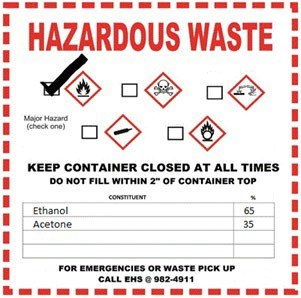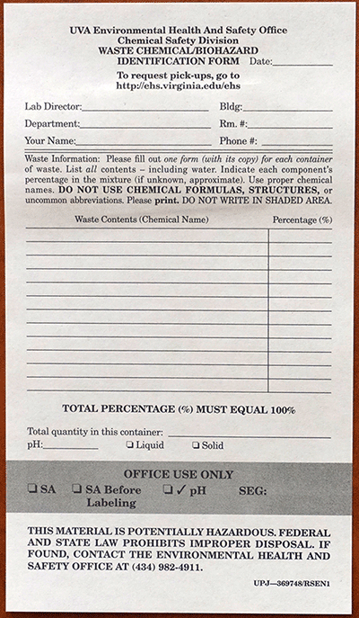Waste Management & Disposal
This section outlines the requirements and recommended guidelines for proper waste disposal.
Importance of Proper Waste Disposal
Hazardous chemical waste is regulated by the Virginia Department of Environmental Quality, following rules established by the U.S. Environmental Protection Agency. Everyone who generates hazardous waste at UVA shares responsibilities for its proper management and disposal. Often called cradle to grave, these responsibilities begin at the time a chemical is declared unwanted and becomes a waste, through multiple handling and transportation steps, and ultimately to final disposal.
EHS manages the overall UVA hazardous waste program, including performing periodic waste inspections and providing information, containers, special labels, and waste collection and disposal services. When in doubt, call EHS (982-4911).
Hazardous waste management rules are complex and carry significant penalties for violation. As a result, it is important that you properly dispose of laboratory waste and unwanted chemicals strictly following these procedures.
General Waste Disposal Procedures
All Hazardous Waste Disposal Containers Must Be Properly Labeled and Kept Capped at All Times.
- All waste must reside in closed, non-leaking containers. Do Not use flasks or test tubes with stoppers, beakers with parafilm, or bottles with ground glass stoppers. The outside of the waste container must be reasonably clean. Do not put liquids (especially phenol) in bottles designed for solids.
- Hazardous waste must never be disposed of in non-hazardous waste trash cans.
- Do not put hazardous waste down the sink or in the trash. Sink drain disposal is limited to dilute, non-hazardous aqueous and water miscible materials, typically buffer solutions, disinfected tissue and cell culture media, and glassware and container rinse waters of non- toxic chemicals. Consult EHS if you have any questions.
- All empty bottles must be defaced, labeled empty, and must remain capped. Dispose of empty, defaced bottles as soon as possible. Bottles that have not been defaced and labeled empty, will be counted as full. Before discarding in a trash can, these containers must be THOROUGHLY RINSED.
- Original chemical reagent containers can make good waste collection containers, but they must be appropriate to the characteristics and properties of the waste.
- Glass bottles should be avoided to the extent possible unless they have a shatter-resistant coating, and metal containers should never be used for corrosive materials. Food and beverage containers are not suitable for chemicals and should never be used for waste.
- Limit waste containers to no larger than 5 gallons (~ 22 Liters) capacity. EHS can also provide suitable waste collection containers.
- Do not put acidic or basic waste (pH <3 or >9) in metal cans. Metal cans corrode in a very short time. Keep acids and bases separated from hydrocarbons and ethers.
- Do not completely fill liquid waste containers - leave a gap of at least 2 inches (about 5 cm) below the cap.
- Keep waste containers closed except when adding waste. For operations that continuously generate chemical waste, high volume waste operations, or for wastes that may evolve significant amounts of gas, contact EHS for special container caps that can be used to accommodate continuous accumulations and prevent pressure build-up.
- Sharps Disposal- Needles (chemically contaminated and non-contaminated), razor blades, scalpels, and other objects that pose a puncture or laceration hazard must be collected in a Sharps container for disposal as regulated medical waste. Only fill containers to about two- thirds of their capacity. No additional waste label or ticket is necessary.
- Sharps containers are available from EHS; Environmental Services (EVS) supplies and picks up sharps containers at Medical Center laboratory locations. Collect other chemically contaminated items such as syringe barrels, capillary tubes, pipettes, and pipette tips in hazardous waste buckets.
- Store hazardous chemical wastes in your established laboratory satellite accumulation area, using secondary containment.
- Place non-contaminated glassware and other glass items in a bag-lined cardboard box and label it with an EHS “Waste Laboratory Glassware” sticker. Once full, close the bag and tape the box shut. These materials are managed as regular trash and can be removed by Housekeeping or taken directly to a trash dumpster. Make sure that you do not overfill these containers leaving enough room to be able to tape the containment bag taped and the box shut.
- Unknown wastes can be dangerous to handle. In addition, they are not accepted by disposal firms. Every effort must be made to identify. EHS will require a department charge code for identifying unknowns should their waste vendor itemize the characterization needed to properly ship and dispose. If a waste (or any other chemical) container has unknown contents, contact EHS as soon as possible for assistance.
- Do Not accumulate more than five 5-gallon cans or carboys, or more than ten gallons in bottles. Larger pickups will have to be scheduled separately.
- Acidic solutions containing METALS (arsenic, barium, cadmium, chromium, lead, silver) should NOT go in 5-gallon carboys.
- When waste containers are ready for pick up, notify EHS by using the on-line Waste Pick- Up Request Form or calling (434) 982-4911.
Special Waste Disposal Precautions
- Ethers tend to form extremely explosive compounds over time. Therefore, date all ether cans. Discard ethers after 6 months from receipt. If you have an old ether can, label as waste call EHS for pick up.
- Do not attempt to open bottles of DRY picric acid. This is an extreme explosion hazard! Any dry bottles of picric acid should be labeled as waste and picked up by EHS staff.
- Other chemicals requiring special precautions include triethyl aluminum (which is highly pyrophoric) and lithium aluminum hydride (which is highly water reactive)
Waste Containers and Labels
- Label every waste container with an approved EHS hazardous waste label, as shown. Waste labels are automatically provided on containers supplied by EHS; they are also available from EHS for reusing chemical reagent bottles. A hazard pictogram must be checked to indicate the hazard characteristic of the waste, along with details on the composition of the waste:

- EHS provides plastic-coated, 1-gallon glass and DOT- approved 5-gallon carboys.
In addition to waste stickers, all waste containers MUST contain a waste disposal ticket issued by EHS. This includes waste that consists of chemicals still in their original containers. Waste will not be picked up if it is not labeled properly.

- Both the label and its no-carbon-required copy should be affixed to the waste container by a single piece of tape across the top of the label, or in such a way that they can remove the copy when they pick up the waste.
- Information that is absolutely required on the chemical waste label includes:
- The name of all possible contents, including stains, water, or any solvents.
- The percentages of each component.
- The total quantity.
- The pH of the waste liquids if it is suspected to be below pH 3 or above pH 10.
- Also include your name, date, department building and room number where the waste is located, phone number, and lab director.
- Important: Disposal companies will not accept unknown chemicals. You must make every possible effort to accurately describe the contents of each container. This means tracking down and questioning previous lab occupants if necessary.
Waste Segregation
Waste segregation minimizes the chances of incompatible materials being mixed together and to keeps disposal costs for the University as low as possible.Avoid mixing different chemical waste streams together - instead collect them by their hazardous properties. Contact EHS for additional guidance (see EHS's waste segregation guidelines) When combining different materials, always check the SDS to be sure they are compatible materials or call EHS for guidance.
Flammables
- Non-halogenated organic solvents, <5% water
- Non-halogenated organic solvents, >5% water
Toxic
- Halogenated solvents (% water unimportant)
- Cyanides
- Formaldehyde Solutions
- Solutions containing compounds of the following metals: arsenic, barium, cadmium, chromium, lead, silver and selenium.
- Any solution containing mercury or its compounds. (Mercury and mercury compounds should be kept separate from any liquid whenever possible.)
Corrosive
- Acids, organic
- Acids, mineral
- Bases, organic
- Bases, mineral
- Photographic stop bath
- Note: Do not put acidic or basic waste (ph <3 or >9) in metal cans. Metal cans corrode in a very short time. Keep acids and bases separate from hydrocarbons and ethers.
Oxidizers
- Inorganic oxidizers
- Organic peroxides
Aerosol Cans
- All aerosol cans
- Note: A recent change in the Virginia Hazardous Waste Regulations requires that all unwanted aerosol cans be collected as Hazardous Waste.
Miscellaneous Waste Segregation
- Photographic fixer
- Photographic developer
- When possible, keep carcinogens, mutagens, and teratogens separate from other wastes
- Keep aqueous wastes separate from organic solvents
- Keep halogenated and non-halogenated wastes separate
- Sulfides
- Pesticides
- Paints
- Oils
- Lamps/Bulbs - Fluorescent lamps and high intensity discharge bulbs contain mercury and must be recycled (building lighting- Facilities Management, lab equipment – EHS).
- Batteries - EHS will take lithium batteries, and damaged/defective batteries. UVA Recycling accepts lithium, lithium ion, lithium re-chargeable, lead acid, alkaline, nickel cadmium, nickel metal hydride, 9 volts, and button batteries.
- All sharps (Needles, razor blades, scalpel blades, etc.), whether they are contaminated with trace chemicals or uncontaminated, must be placed in a sharps container. Always use the sharps container with the top in place. Sharps container are available from EHS.